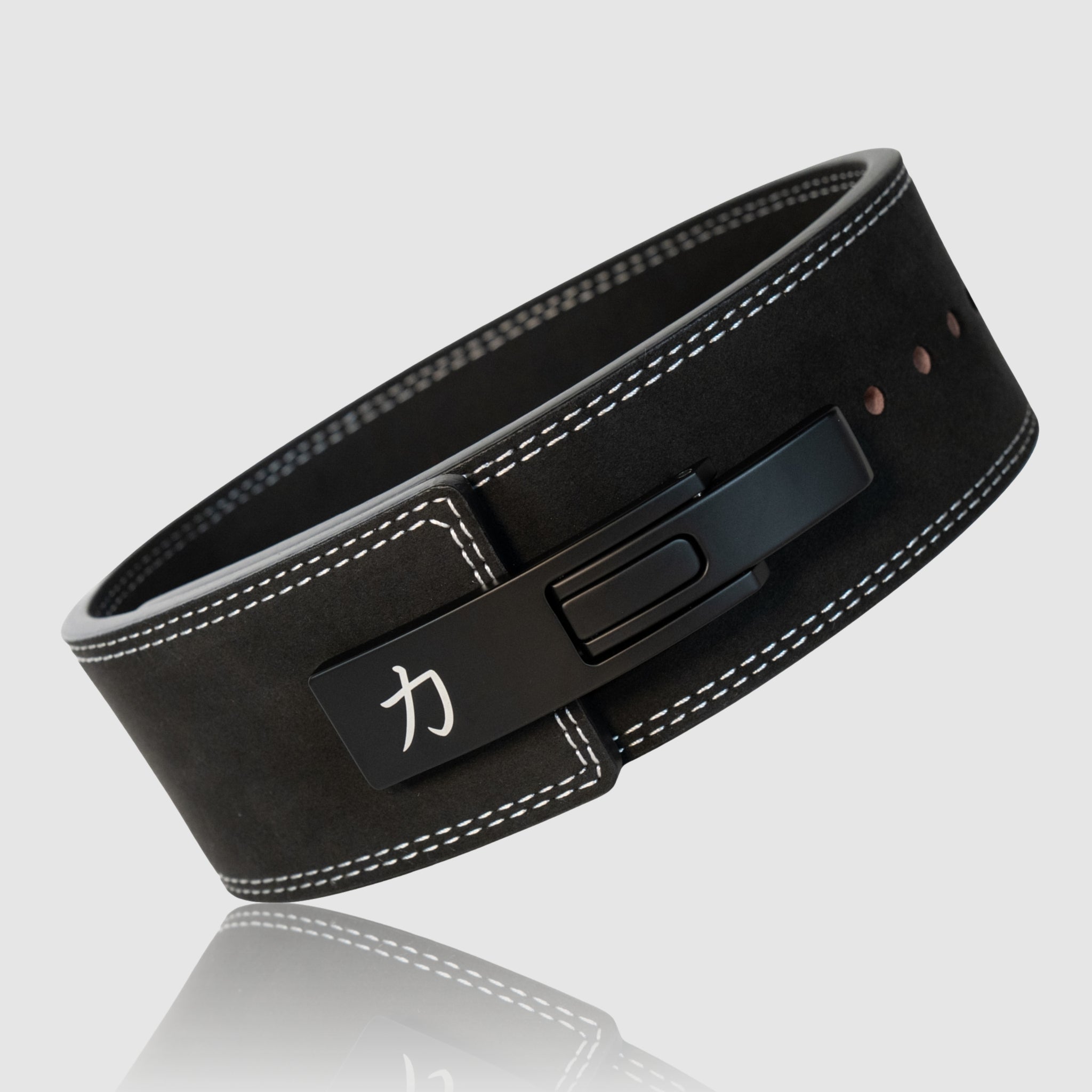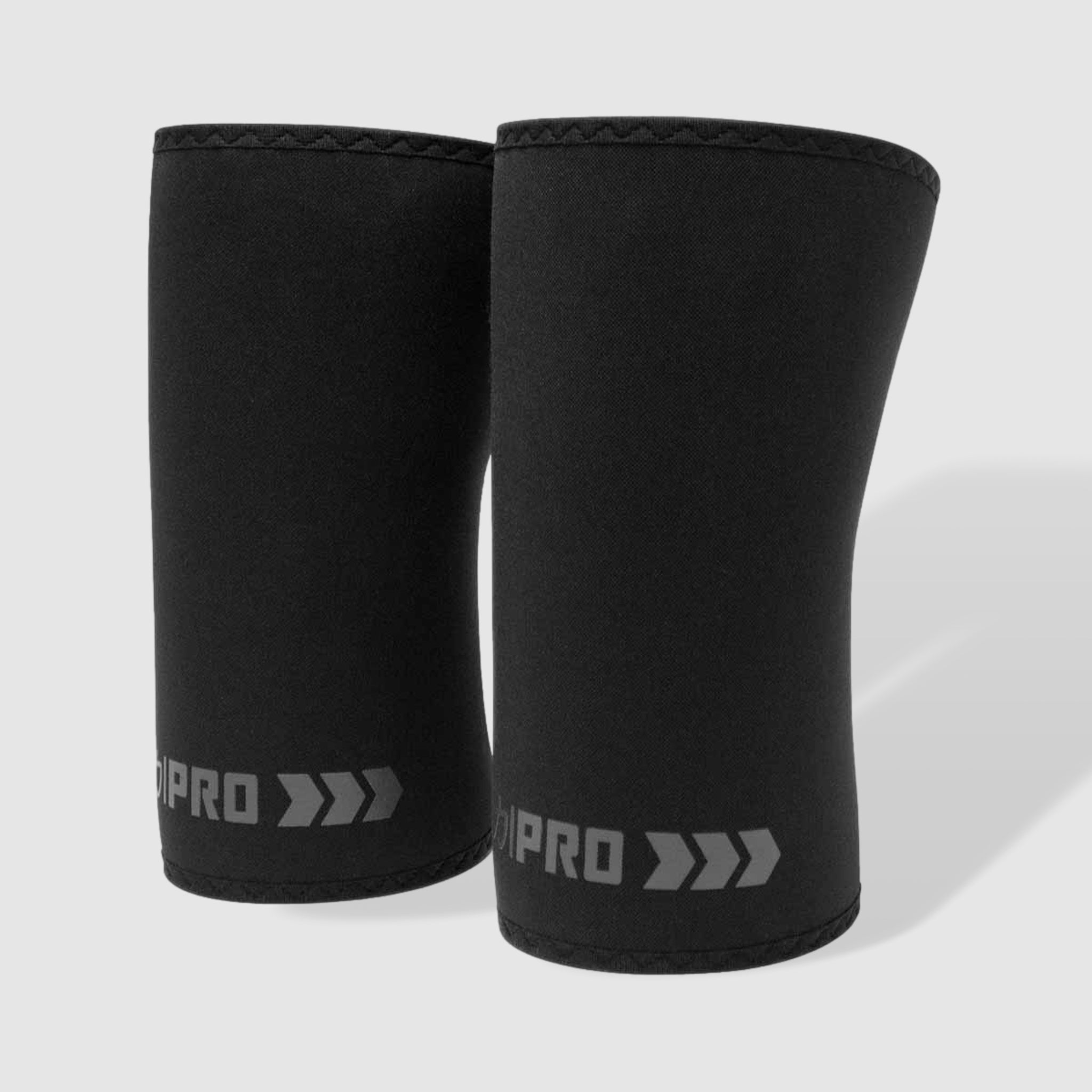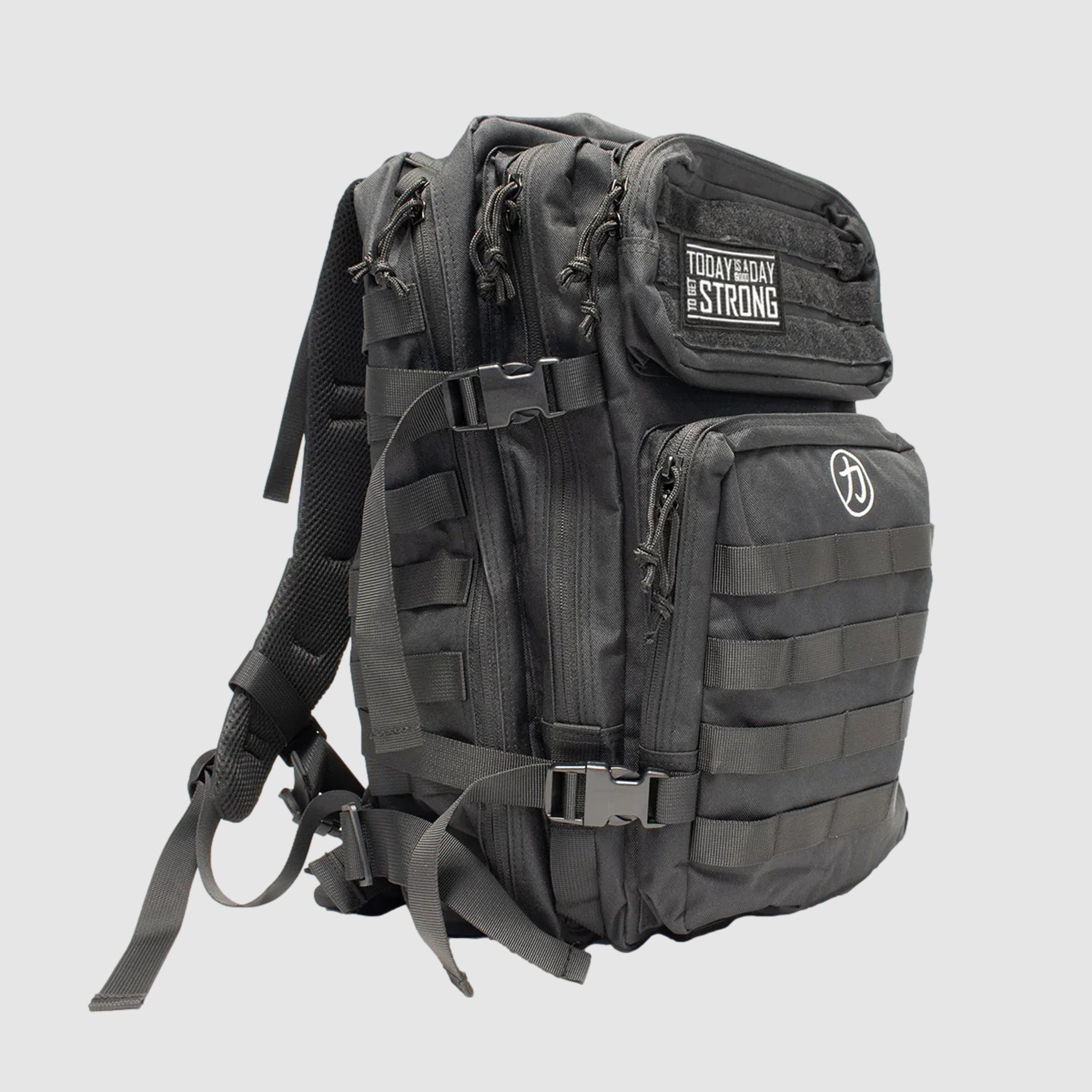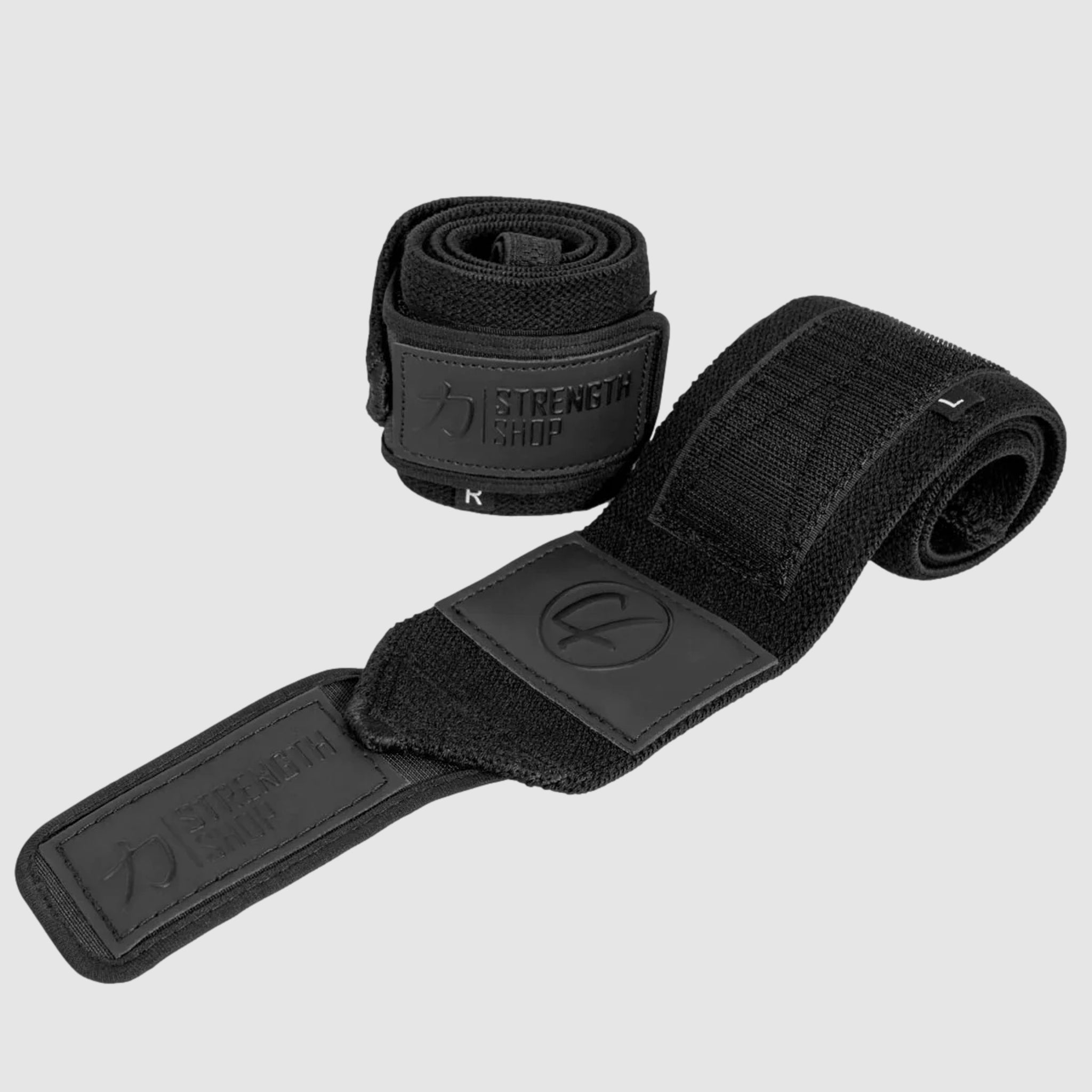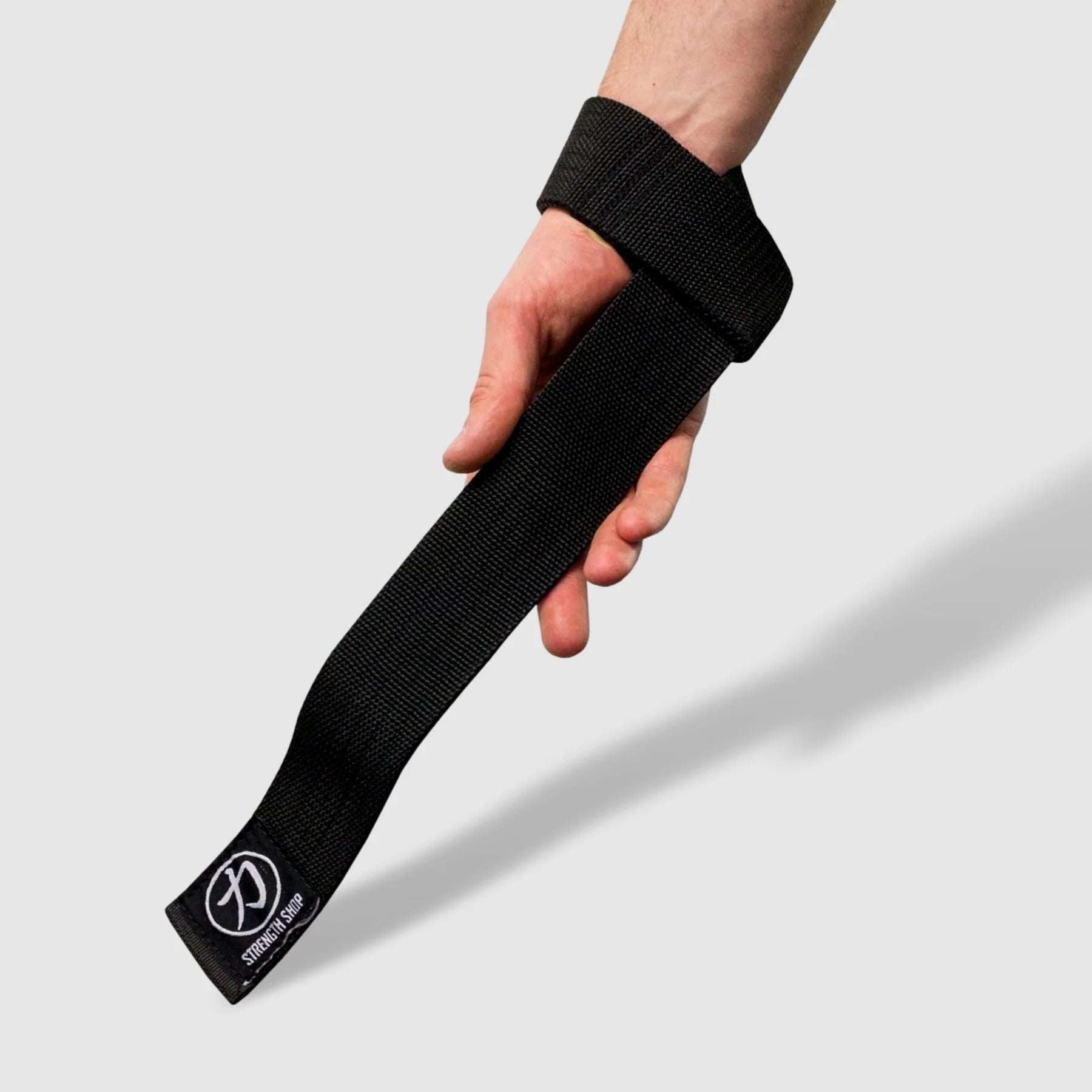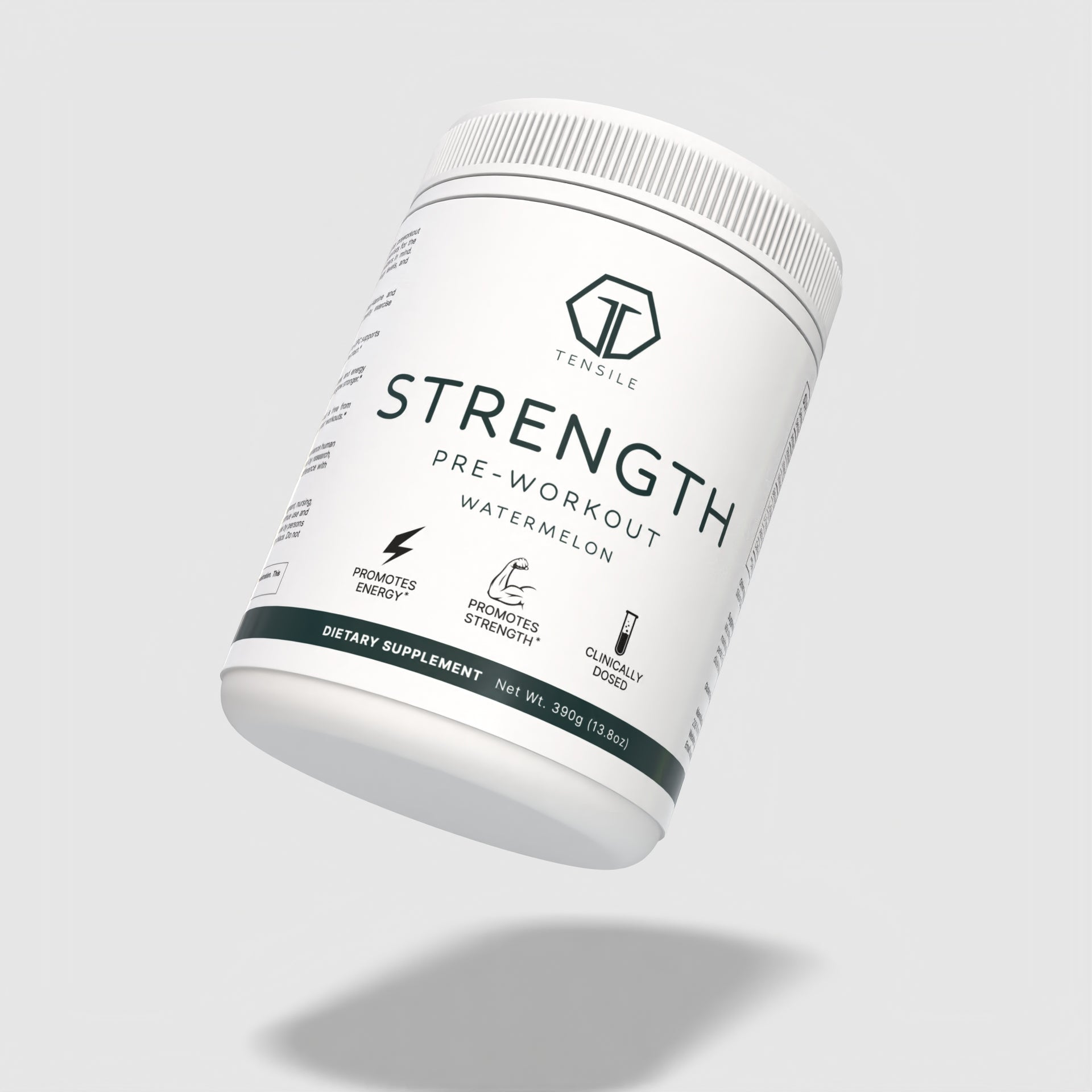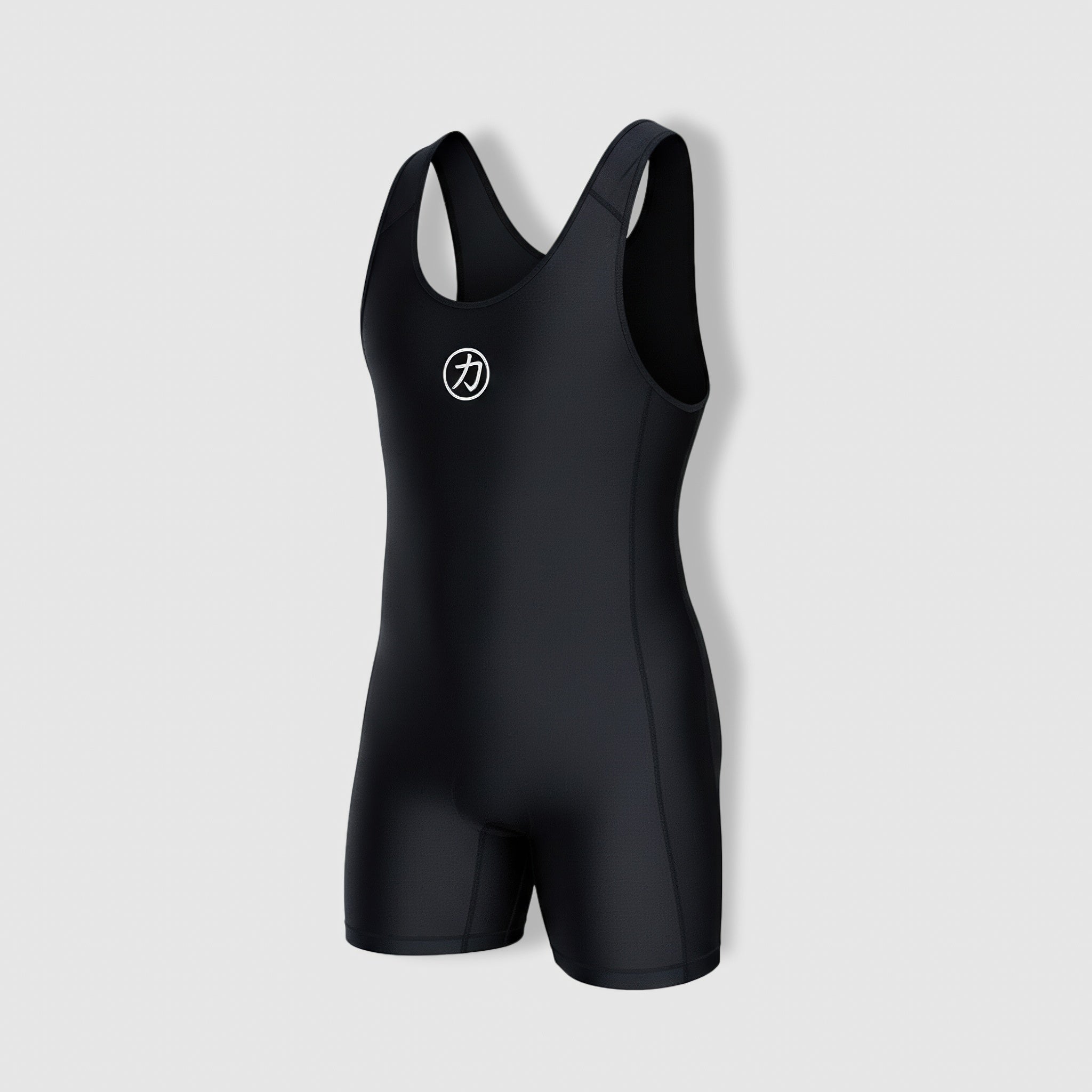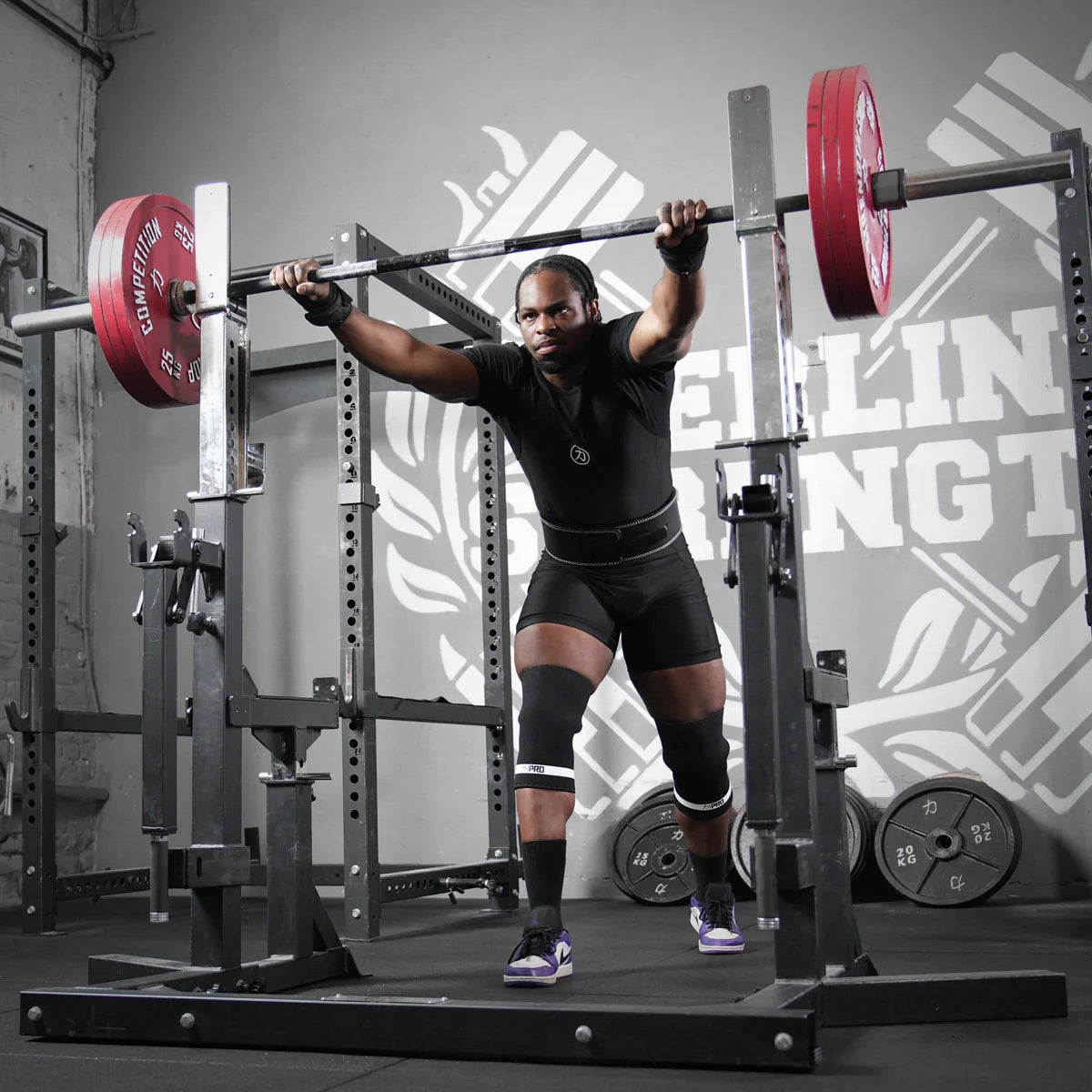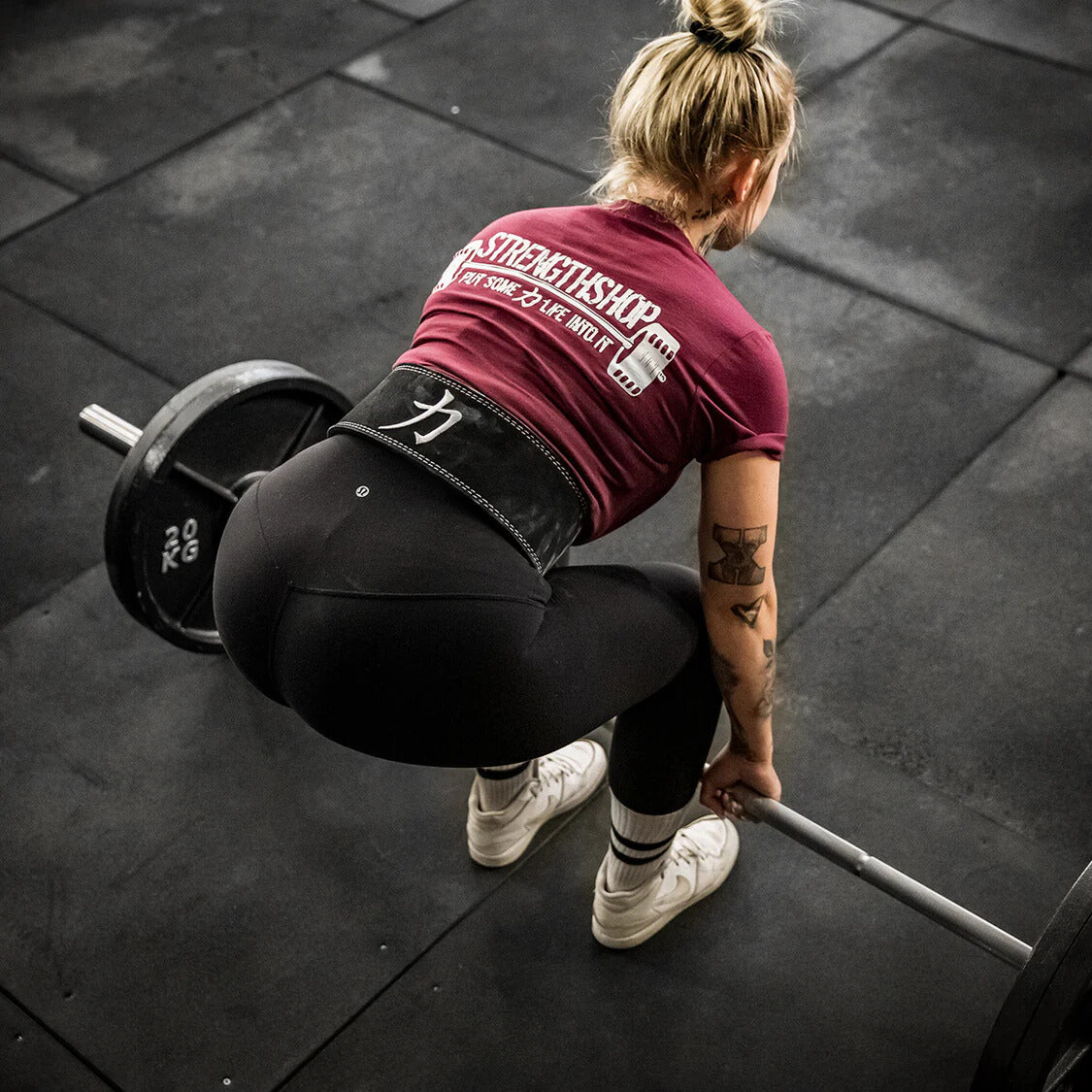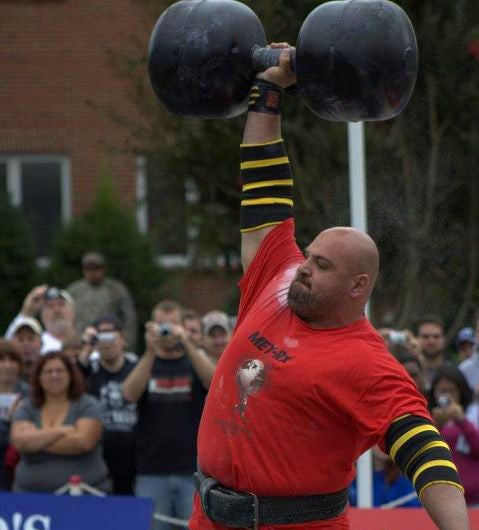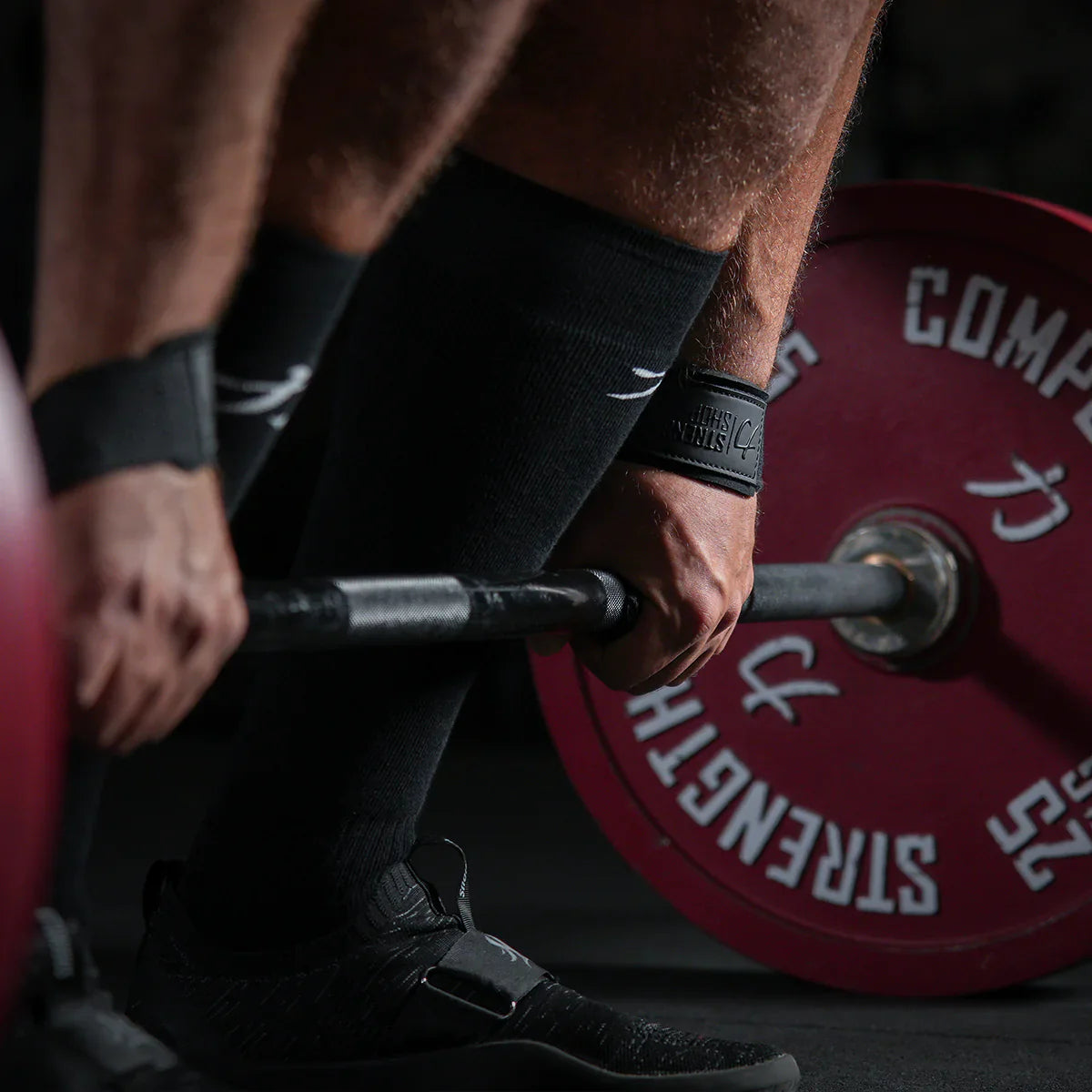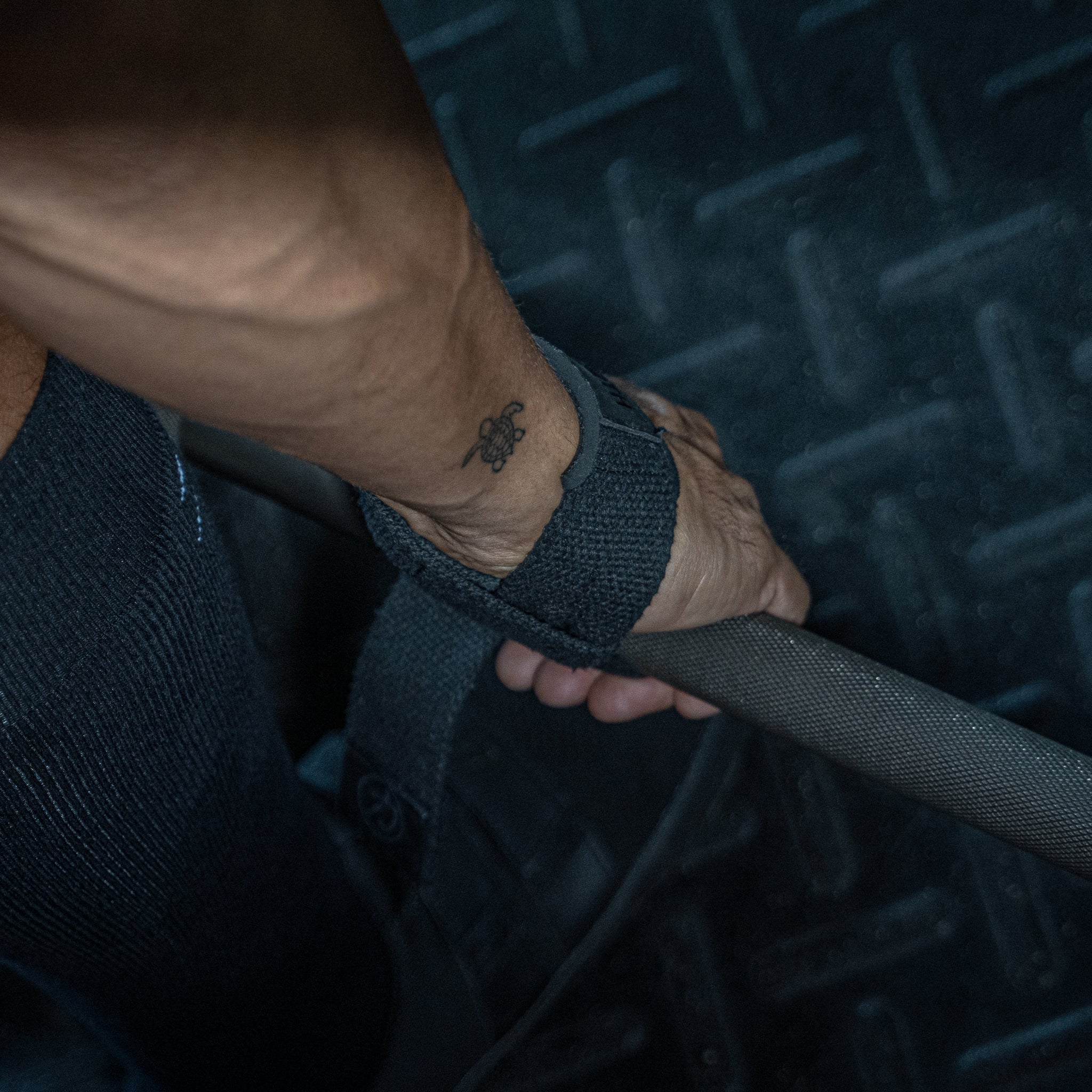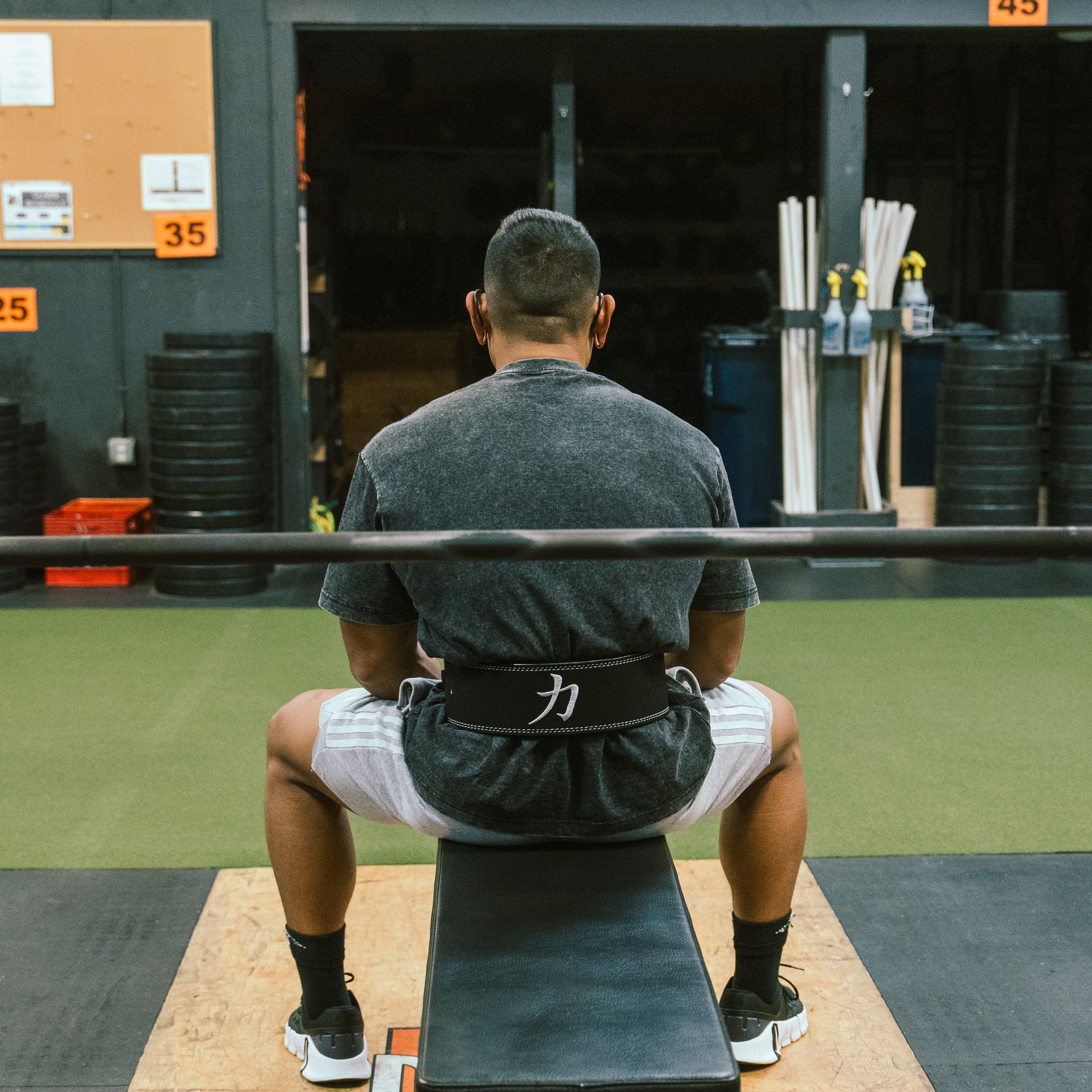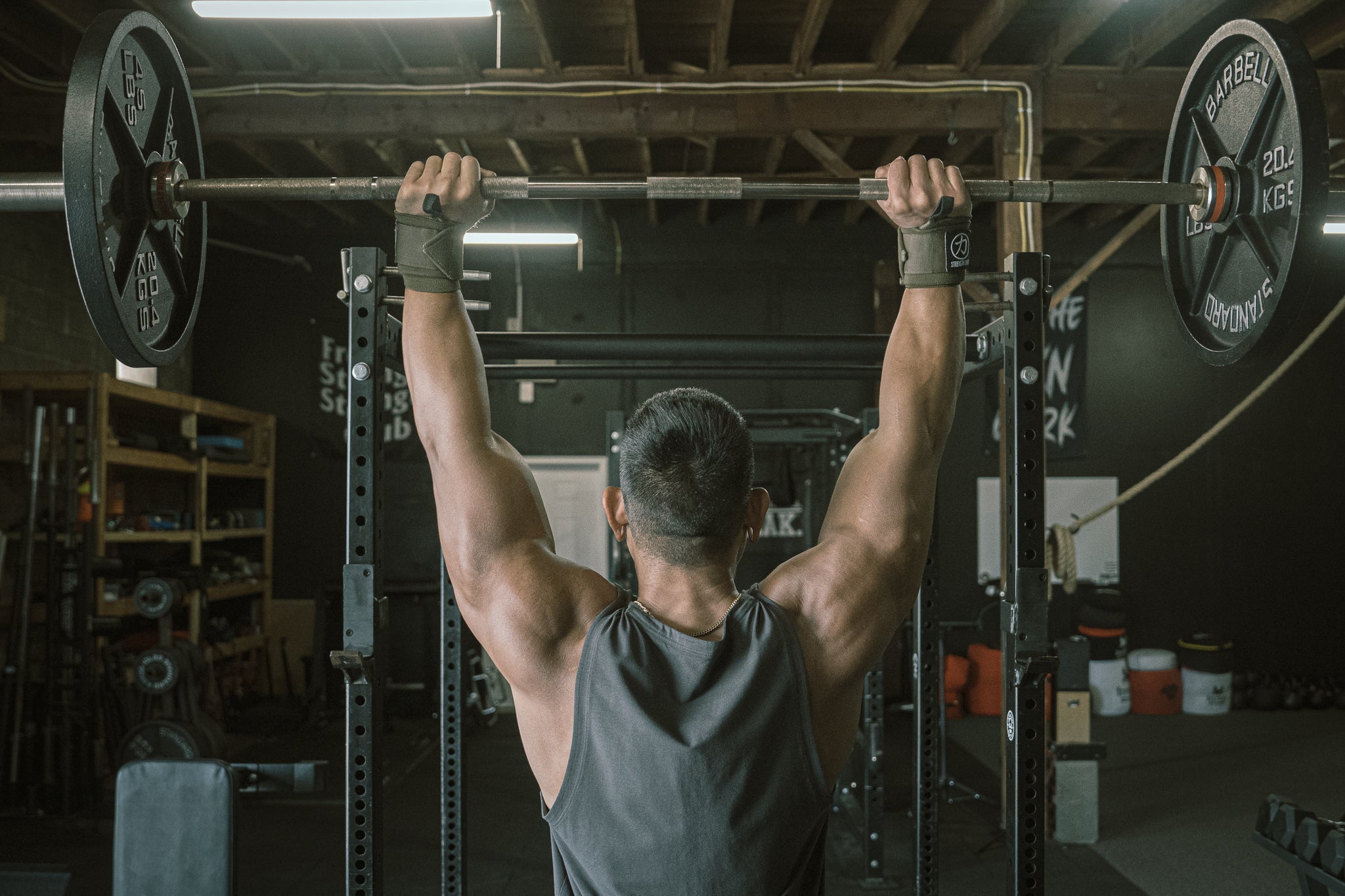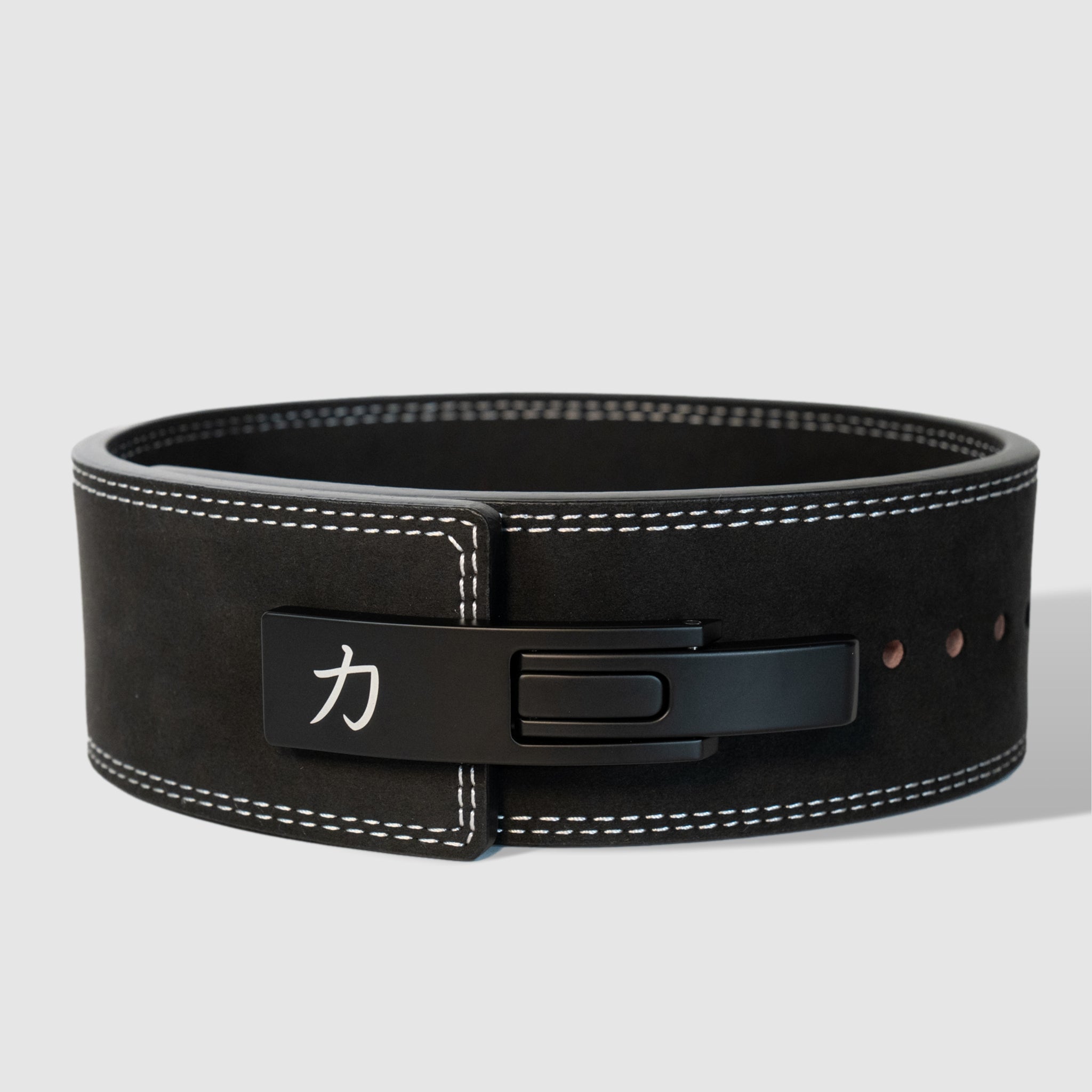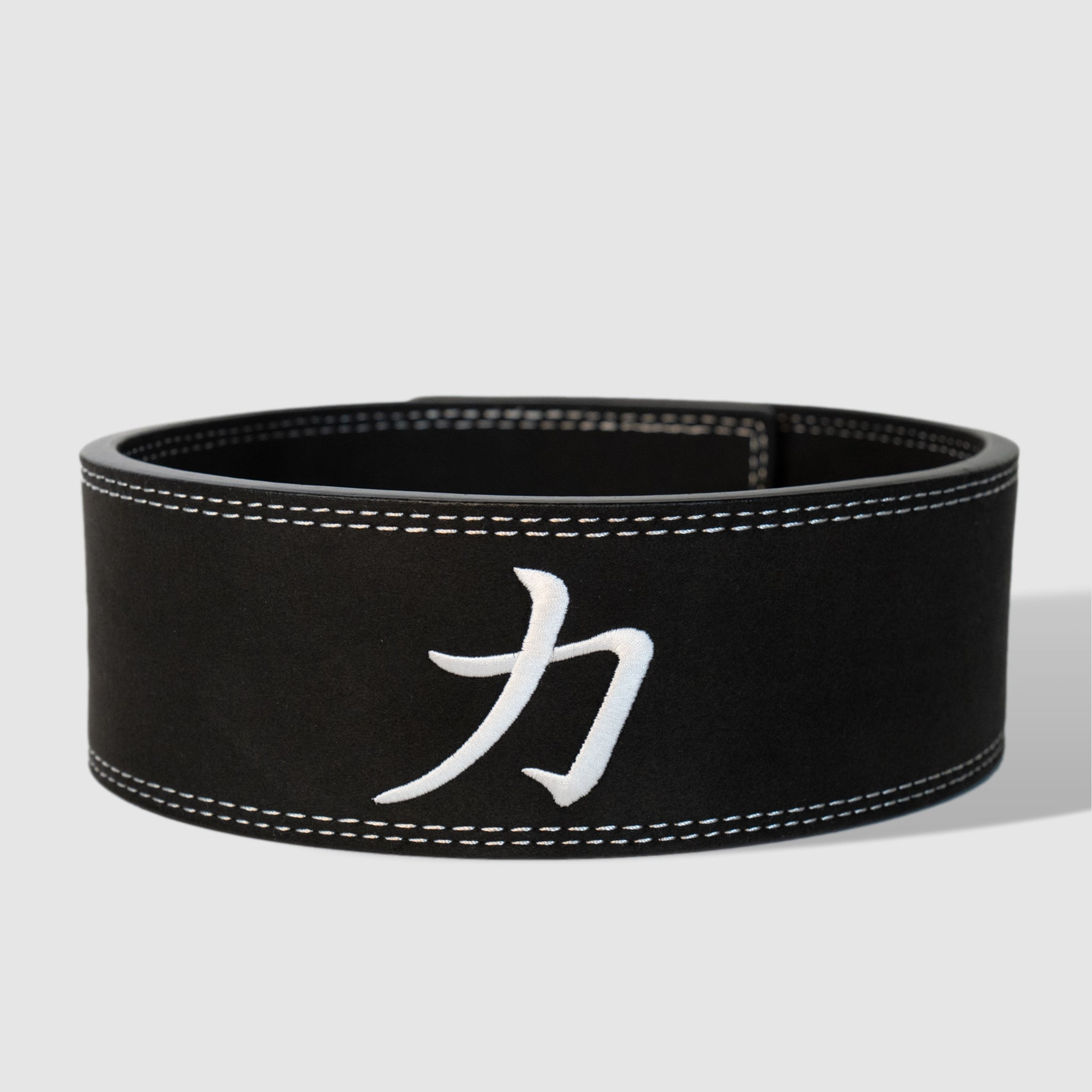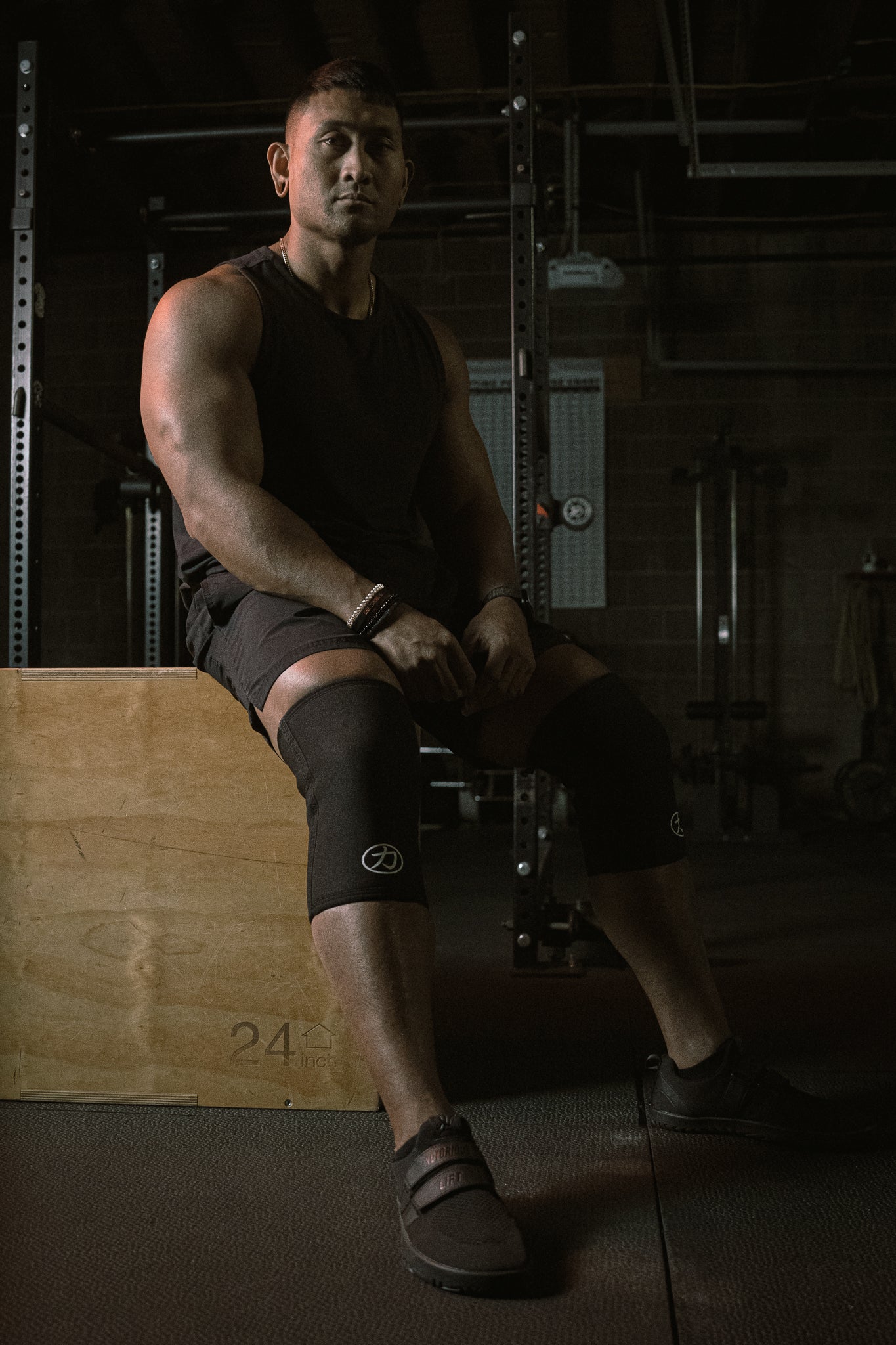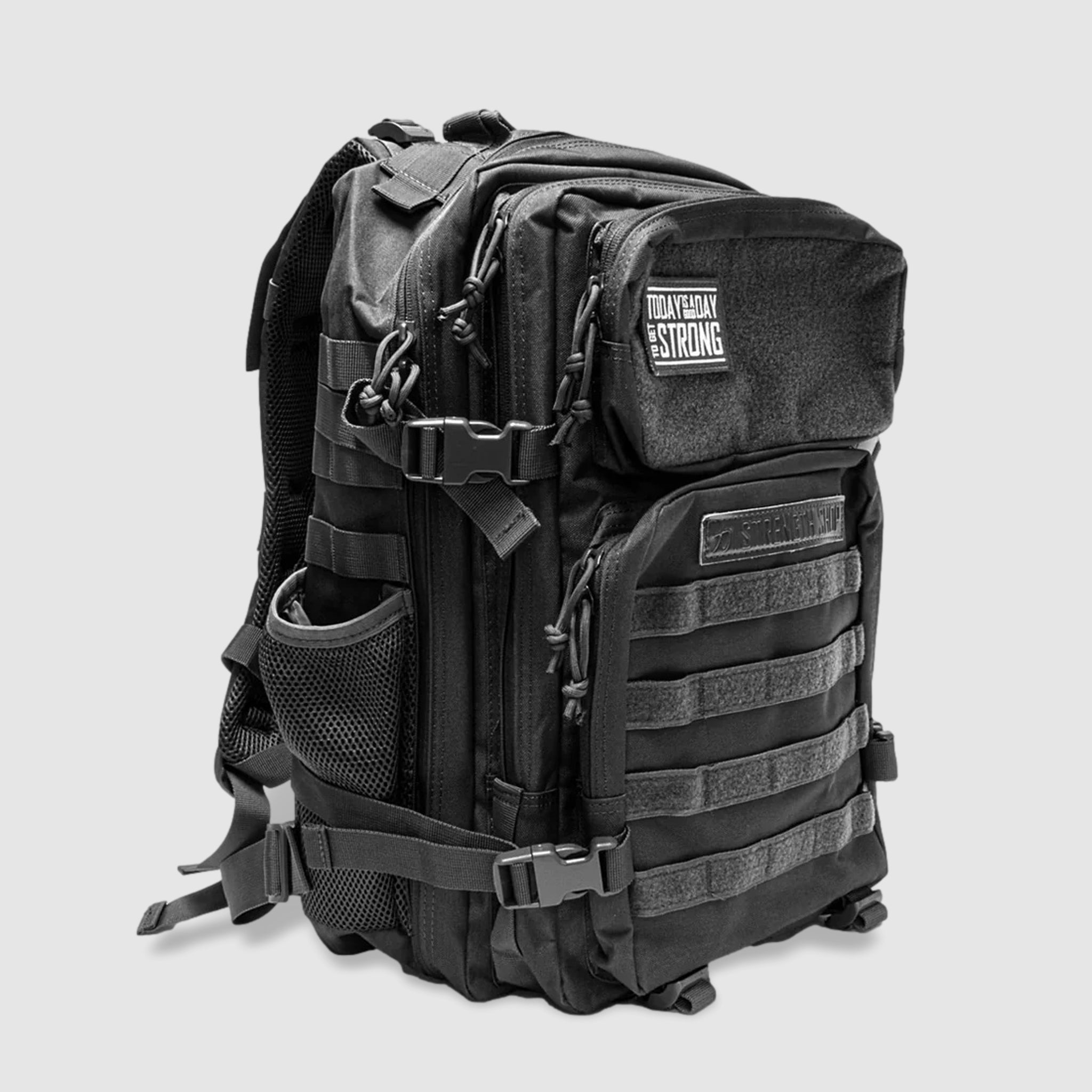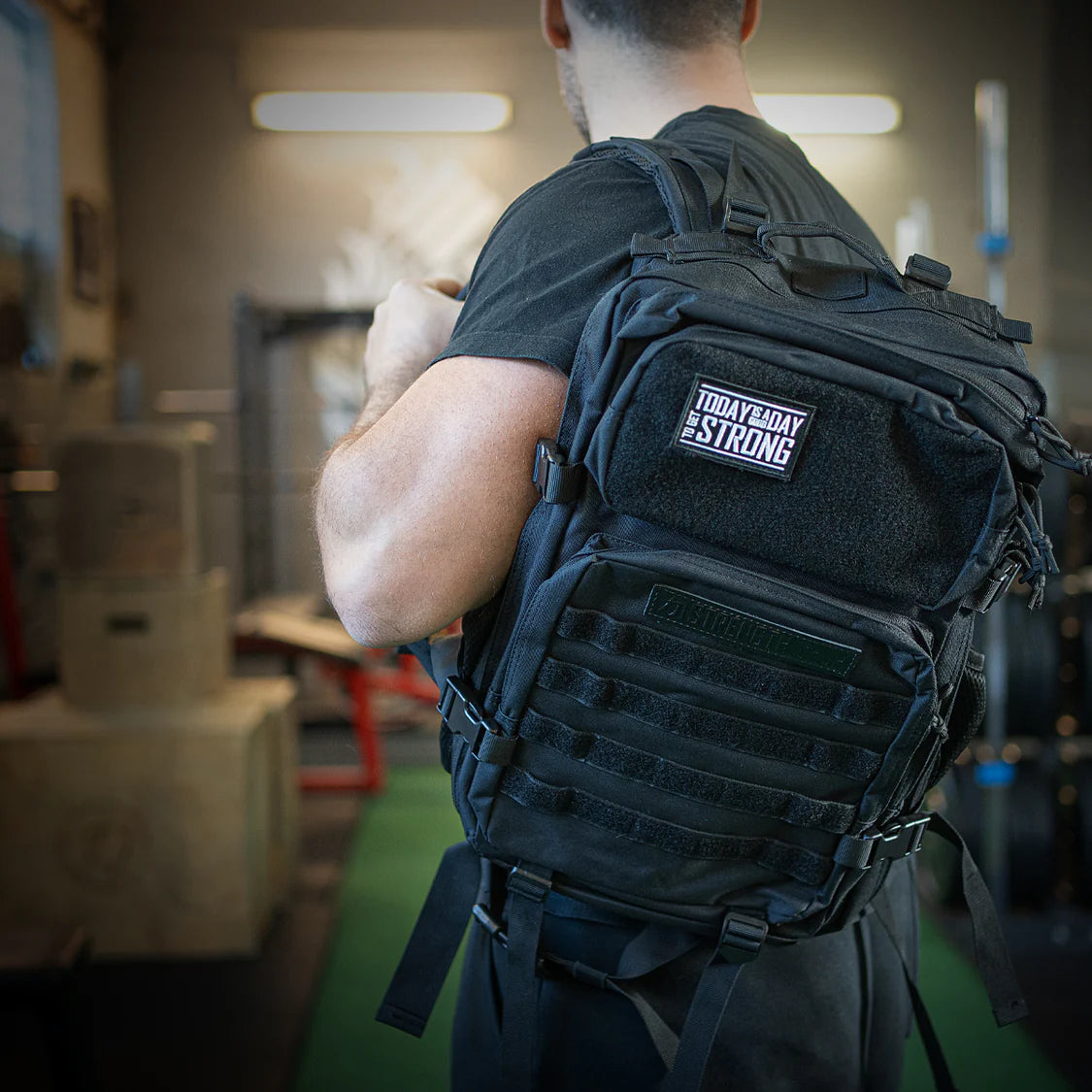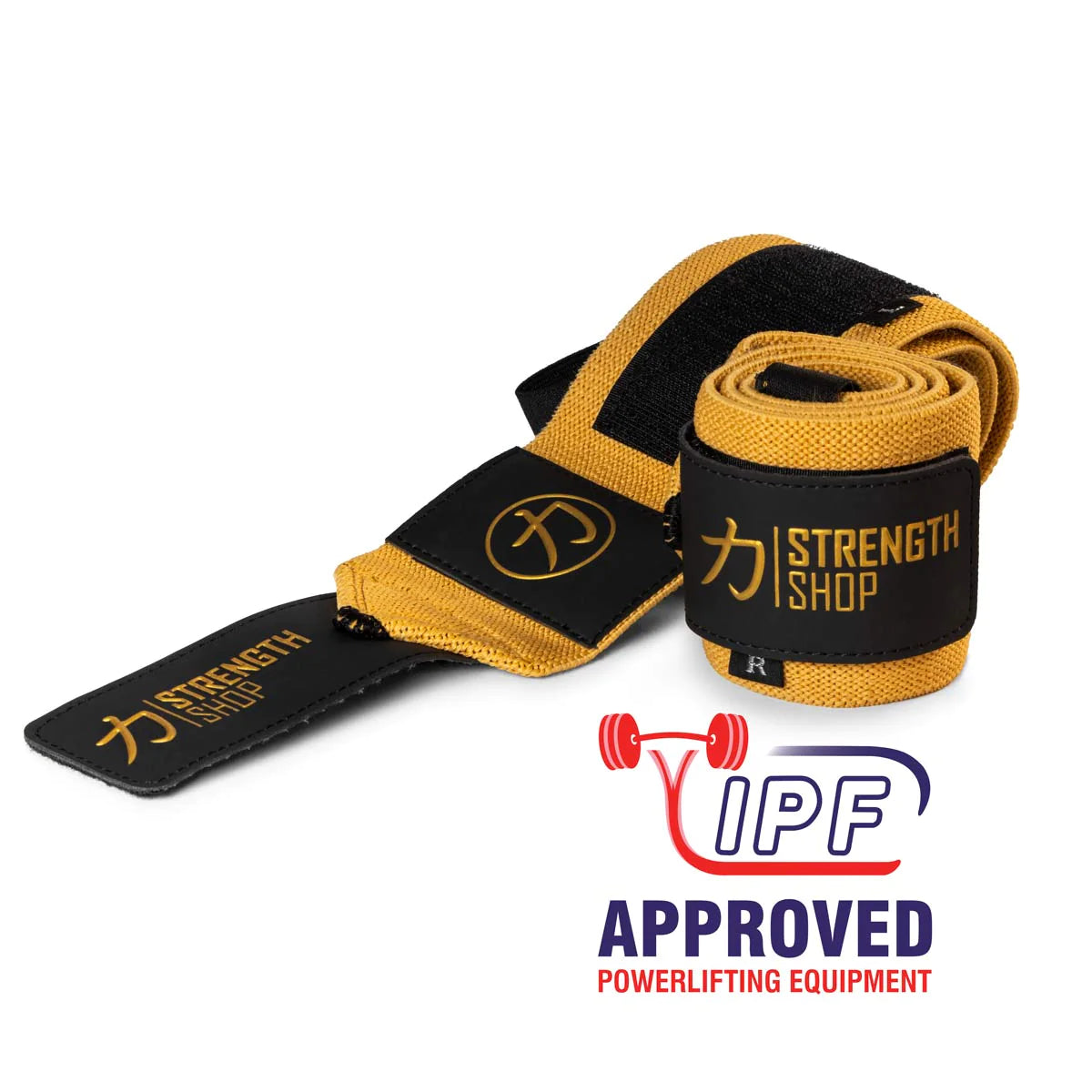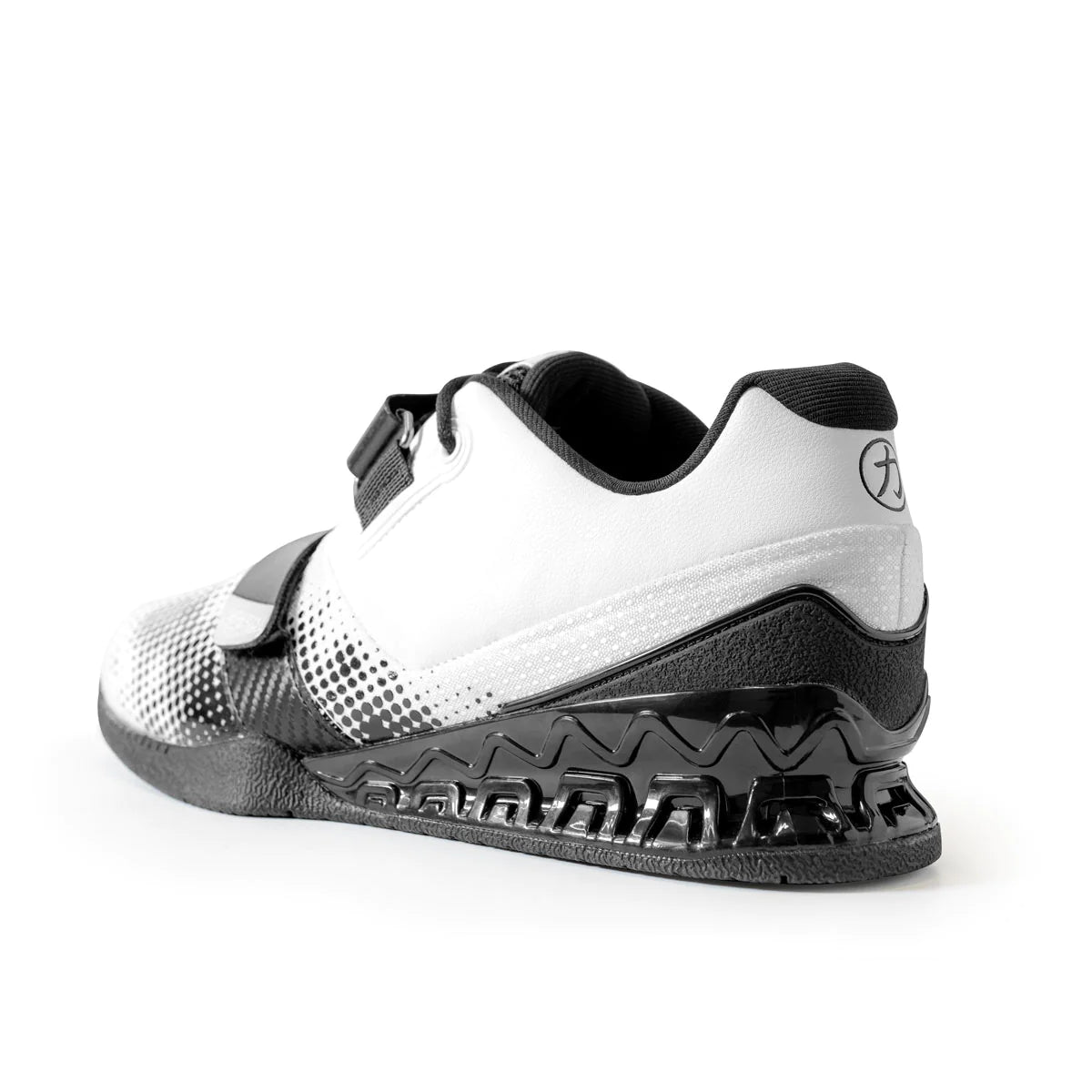Knee sleeves can change the way you train. If you're lifting heavy or working through chronic knee discomfort, this simple accessory can offer the compression, warmth, and support your joints need.
When should you actually wear knee sleeves? Let’s break it down so you can use them effectively and get the most out of every squat, lunge, and lift.
What Are Knee Sleeves?
Knee sleeves are a form-fitting compression accessory that you wear over your knee joint to provide support during strength training. They’re typically made of neoprene or elastic fabric and come in various thicknesses. Manufacturers design them to improve stability, joint awareness, and circulation. They're a go-to for powerlifters, CrossFit athletes, and weightlifters alike.
If you are a competitive powerlifter, consider pairing your knee sleeves with accessories such as a lifting belt, a powerlifting singlet, and a pair of high-quality deadlift shoes to maximize your performance during your lifts.
How Do Knee Sleeves Work?
Knee sleeves work through compression and heat retention. When you slide on a snug-fitting pair, they:
-
Increase blood flow to your muscles and tissues around your knee.
-
Support joint alignment during your movements.
-
Reduce lateral motion that could lead to strain.
-
Improve proprioception, or your body’s awareness of joint position.
If you're training hard, sleeves give you the support you need to keep pushing through volume or intensity. This can mean better technique, heavier weight lifted, less joint stress, and faster warm-ups.
6 Benefits of Knee Sleeves for Lifting
If you lift regularly, your knees take on a lot of stress. Knee sleeves can help by offering both physical and mental support.
1. Support Under Load
During squats, Olympic lifts, or any movement that challenges your knees, stability is critical. Knee sleeves provide compression that supports proper alignment and minimizes excess joint movement. With more control over your knees, you’ll feel more secure and confident under the bar.
For extra support, you can use wrist wraps or lifting straps to lift more efficiently.
2. Improved Performance
Using ultra-stiff knee sleeves can typically add 5 to 15 kg (11 to 33 lbs) to your squat 1RM, depending on several factors, such as your stance width. Generally, narrower stance squatters benefit more since they produce more knee flexion in the hole.
Anecdotally, many lifters report feeling more powerful and stable during heavy lifts while they’re wearing knee sleeves, which can translate to more reps, smoother form, and even PRs.
3. Potentially Improved Recovery Times
The compression from knee sleeves improves circulation, delivering oxygen and nutrients to your working muscles.
A 2017 meta-analysis in the Journal of Sports Medicine found that compression garments like knee sleeves helped accelerate strength recovery, especially two to eight hours and more than 24 hours after resistance training. In other words, wearing sleeves during your workout may help reduce soreness and speed up recovery.
4. Reduced Pain
If you deal with chronic soreness, tendonitis, or lingering knee discomfort, sleeves can offer relief. By improving your blood flow and providing compression, they reduce swelling and ease pressure on your joints. They’re especially helpful if your pain usually fades after warming up, as they help retain heat and get your knees moving more smoothly sooner.
5. Injury Prevention
Knee sleeves won’t prevent injuries on their own, but they support proper joint tracking and reduce strain on your ligaments and tendons. They also improve proprioception, which helps you maintain better form under load and reduce risky movement patterns.
Do you incorporate accommodating resistance techniques — such as bands or chains — in your lifts? Knee sleeves can offer added joint support by helping stabilize your knees as resistance increases throughout the range of motion.
6. Better Movement Awareness
Knee sleeves improve proprioceptive feedback, helping you feel where your knees are throughout a lift. That awareness makes it easier to hit proper depth, stay aligned, and refine your technique, especially during complex movements like cleans and snatches.
How to Use Knee Sleeves Properly
Maximize the benefits of knee sleeves by wearing them with purpose.
Step 1: Find the Right Fit
Measure the circumference of your knee at its widest point. Your sleeves should feel tight and supportive but not cut off circulation. You should be able to bend your knees without pain or pinching.
Step 2: Time It Right
Start your session without sleeves during mobility and warm-ups. Put them on when the weight gets heavy or the reps get high.
Step 3: Don’t Overuse Them
Wear sleeves for your working sets, but take them off between exercises or lifts when possible. This helps keep your joints strong and your muscles engaged.
Step 4: Clean and Care for Them
Knee sleeves can get sweaty fast. Wash your sleeves regularly, air-dry them, and avoid high heat to prevent wear.
How to Choose the Right Knee Sleeves
There’s no one-size-fits-all approach. Choose your knee sleeves based on your training goals, fit preference, and experience level. Here are some factors to consider.
Thickness
-
5 mm: Best for general training, CrossFit, or workouts that mix lifting and movement.
-
7 mm: Great for powerlifting and heavy lifting when you want max support.
Material
-
Neoprene: Offers structure, warmth, and durability.
-
Elastic blends: More breathable and flexible, better for longer workouts or dynamic movement.
Fit
They should be snug enough to compress, but loose enough for your knee to fully flex. If you feel numb or tingly, go up a size.
When to Use Knee Sleeves
Knee sleeves are not meant for every lift, but they’re very useful when you deal with heavy weights or high-intensity training. Knowing when to use them can help you get the most out of your workouts.
-
For heavy lifting: Wear them when training at 80% or more of your one-rep max to help stabilize your knees under load. Consider a lifting belt during squats for additional support.
-
For compound movements: Use sleeves for squats, lunges, cleans, and snatches — any lift that challenges multiple joints.
-
For volume days: Support your knees during high-rep leg work to reduce joint stress and recover faster.
-
For rehab or recovery: Use sleeves to support healing joints, reduce pain, and improve circulation after injury or surgery.
-
For managing chronic knee pain: Add compression and warmth to help reduce inflammation and improve comfort during training.
When Not to Use Knee Sleeves
While knee sleeves are great for heavy lifting, you don’t need to use them all the time.
-
For light sets or warm-ups: Let your knees move naturally to build resilience and activate stabilizers.
-
For mobility work: Skip sleeves when working on flexibility or correcting movement patterns to avoid masking imbalances.
-
For injuries: If you have acute knee injuries like ligament tears, meniscus damage, or severe inflammation, avoid using knee sleeves and seek medical guidance before resuming training. If you have serious injuries, always consult your doctor before hard workouts or using any additional gear.
Frequently Asked Questions
Are knee sleeves necessary for weightlifting?
No, but they’re helpful. They offer support, warmth, and stability during heavy compound lifts like squats and deadlifts.
Do knee sleeves improve performance?
They can. Compression helps with alignment, blood flow, and proprioception, which leads to more confident, effective lifting.
Can knee sleeves prevent injuries?
They reduce the risk of overuse injuries and help keep joints aligned, but they’re not a substitute for good form, programming, and recovery.
How tight should knee sleeves be?
Tight enough to compress and support, but not so tight that they cut off circulation or limit your movement.
Should beginners use knee sleeves?
Beginners can benefit from wearing knee sleeves, especially if they have knee pain or are lifting heavier. But early on, it’s more important to develop good movement patterns and strength without support.
Can knee sleeves be worn all day?
No. You should only wear them during training. Prolonged use can lead to over-reliance or reduced muscle engagement.
When should I replace knee sleeves?
If they stretch out, lose compression, or start to tear, it’s time for a new pair.

